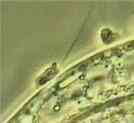Catenaria anguillulae is a member of the Chytridiomycota, the only major group of true (chitin-walled) fungi that produce motile spores, termed zoospores. This fungus can be grown easily on culture media but in nature it is often found as a facultative (non-specialised) parasite of nematodes, the eggs of liver flukes, or other small organisms. The images below were taken from videotapes, using phase-contrast microscopy, and show the behaviour of this fungus when parasitising nematodes. |
||||
|
|
||||
| A. Three zoospores, each
with a single posterior flagellum. The
zoospore on the left shows a conspicuous nuclear
cap (see pointer) which contains ribosomes and
is located above the nucleus (seen as a lighter body
which extends to the base of the flagellum). Ordinarily
it would not be possible to see the flagellum because it
beats rapidly, but these zoospores have stopped swimming
and are crawling across a glass surface (amoeboid
crawling). Two of the zoospores show conspicuous
pseudopodia, marked by arrowheads B. Two zoospores crawling along the surface of a nematode; the flagella are clearly seen (arrowhead). C. Five zoospores (the centre one is out of focus) that were attracted to a specific site on the nematode - the bulb region (heart-shaped) where an excretory pore (not seen) discharges compounds that cause zoospores to accumulate by chemotaxis. One of the zoospores recently arrived at this site and we can still see its flagellum (arrowhead); the other zoospores have encysted and withdrawn their flagella. D. Three zoospore cysts (marked 'c') that germinated on a glass surface. Each produced a narrow outgrowth tube which swelled to form a vesicle (ves), and narrow rhizoids (rh) developed from the vesicles. Lipid bodies are seen as bright globular structures in the vesicles and some of the cysts. E. Several zoospores were attracted to the tail region of a nematode, near the anal pore (not seen). They encysted and produced vesicles and rhizoids, many of which are inside the body of the animal. At a later stage of development, the vesicles will become sporangia: their contents will be cleaved to produce zoospores which will be released to repeat the infection cycle. For further aspects of Catenaria zoospore biology see Chytrid zoospores Further reading: JW Deacon & G Saxena, 1997. Mycological Research 101, 513-522. |
||||
Can Catenaria be used to control nematodes? We do not know, but the question is worth considering because some nematodes (the eelworms, about 1 mm long) cause major damage to crop plants, and others (the roundworms) are important parasites of humans and domesticated animals. There are several points to consider when trying to use a living organism as a control agent. Some of them are discussed below. Others can be found in the other Biocontrol Profiles:
|
||||

